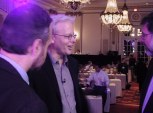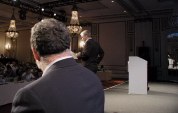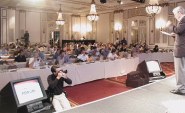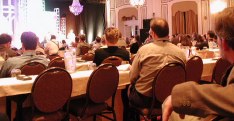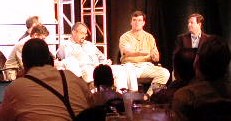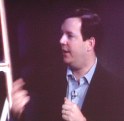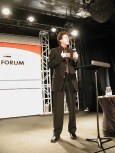InfoWorld CTO Forum 2001 | home
The Rest of Wednesday
After the break it was time for the panel I was there to join: "The New Peer-to-Peer App". I guess the old Cornucopia of the Commons essay gets me on these things. Trellix doesn't do P2P -- we do private label, server based, web authoring and hosting services. People tell me it makes me more objective...
Ray Ozzie of Groove showed up right before the talk (and left soon after, unfortunately). We had talked on the phone last week, so we had coordinated a bit and I knew some of the latest about his stuff. I had read about SETI@home (panelist Dan Werthimer's system) in the O'Reilly Peer to Peer book and talked a bit with Dan and moderator Glenn Ricart of Centerbeam at the speakers' reception.
Talking all together right before as they put on our microphones, the view from on stage as the panel is introduced
There is a report on our session on InfoWorld's web site, though there is a minor misquote: I ended with "You will be talking about this topic on P2P".
I made some of the points from my essays, such as the new Taxonomy one and the new part in the Cornucopia essay about getting many useful names to aid searching by letting the users name things themselves.
Dan told how SETI has enough systems helping them that they are the world's most powerful supercomputer, and growing. Very successful.
Ray made a very important statement in giving an example about P2P: He described the situation about comparing instant messaging with centralized servers required vs. direct P2P or just simple relaying. Regular instant messaging can run, let's say, 2,500 simultaneous users on one server. If you go to encrypted communications, that drops to 100 per server or something, because of the heavy computational load. (One user PC has no problem keeping up, after all, the servers' CPUs are usually only a few times more powerful than the user machines at most in computation.) Once you add more app-level processing on the server, you get 25 users or something per server. If you need to size for peak operation, such as during an emergency, that could be very expensive in a large organization. On the other hand, P2P instant messaging does all that work on each machine, so it scales to any number you want, as long as each person only talks with a most a few people at a time. So...there are obviously lots of what I call Person-to-Person applications where P2P topologies are much more efficient and much more scalable than the hosted version. Privacy and other compute intensive processing could be the "killer app" of P2P.
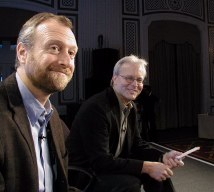
My view of Dan and Ray
After our panel, I stayed around to talk to people as they came up. I missed the sponsors' pitches in breakout rooms upstairs.
The lunch speaker was Alan Cooper of Cooper Interaction Design:
Alan Cooper speaking
For this, I took notes on my Palm with a Stowaway keyboard. I find it so much easier to type than write while listening. Here are my notes, transferred from WordSmith on the Palm with minor editing:
dotComs were last gasp of old industrial economy. Saving time, money, and number of people aren't what you get with computers. What you get is Adaptability, Flexibility, Scalability - that's the best return on investment from info technology. Design with narrow focus, rather than long list of features -- not the sum of all suggested features. List of "features" of what's in a building doesn't make a spec of a building. If you ask people what they want they will give you the wrong answers or maybe not but they don't know for sure and you don't know for sure. You must use interaction design. (See his web site and read his books.)
We aren't creating smart appliances, we are making computers with interesting peripherals.
VC told him "that first to market thing didn't work out, so now we're working on last man standing"
It was a good talk. I have some differences of opinion with him about the value and role of the browser, but much of what he says about users fits with what I've seen.
There were more sessions in the afternoon. The first was on "Customer as Tyrant", which was followed by more sponsor breakouts. The customer panel had Barry Briggs of Wheelhouse, Joshua Levine of E*Trade, Mike Oeth of Liveperson, and Mike Ragunas of Staples.com. I didn't take notes, but remember Mike telling how Staples makes the web access work in the store so you can use the browser to order stuff and then go up to the cash register and it's already in there, ready to pay with a physical credit card. A great example of integration in the post "eCommerce will wipe out physical commerce" world.
Watching the "Customer as Tyrant" panel, Mike Ragunas of Staples
The evening had a dinner with comedian David Brenner as entertainment. I didn't take notes. One representative joke I remember: NY cabbie's main complaint is of passengers defecating on the rear seat. He thinks that's easy to solve: The taxi cab drivers should just slow down...
David Brenner
He only smiled briefly at a time. He seemed to keep one expression, but when I tried many pictures to get one somewhat flattering one, I found that he really had all these wonderful expressions. I also noticed he'd look down at some notes once in a while. He put them in his pocket before he left the stage, so I only got to see them from a far briefly (I'm always interested in how professionals do their work and especially in how people prepare for on-stage presentations). It looked like he had one 6x9 card or so with phrases separated by red highlighted marks. I guess it was a list of each of the sets of jokes (cabs, childbirth, baldness, etc.) he was planning to do and the order. Maybe not.
